At a glance
- The FLAMINGO research project is investigating the extent to which the individual control of rotor blades is capable of not only reducing signs of fatigue and noise but also how far the power yield can be positively influenced.
- The overall project aims at developping a holistically optimized control system for blade pitches (IPC).
- As part of a subproject, the Fraunhofer IWES is responsible for creating a robust data basis and the subsequent evaluation thereof. Based on this, the institute hopes to arrive at optimization options for IPC.
The challenge
Modern wind turbines have rotor diameters in excess of 100 meters. This enormous span width means that the rotor blades, and in particular the blade tips, are subjected to greatly varying wind speeds in each rotation. A control system that considers this phenomenon can not only improve the power yield of a turbine, but also prevent the fatigue damage caused by blade angle misalignment. Modern turbines currently normally use a collective pitch control (CPC), which adjusts all the blade pitch angles simultaneously to the given conditions. The disadvantage of this is that if the angle of attack of all the rotor blades is reduced, the energy yield of the wind turbine can also drop significantly.
The solution
One alternative to this is a control system, which allows the pitches to be adjusted individually (IPC) and thus takes better account of the varying flow profile. Within the scope of the FLAMINGO project, the focus is on achieving a holistic examination of a control system, which not only improves the energy yield of wind turbines and reduces the signs of fatigue, but also causes lower noise emissions and positively influences the flow field behind the rotor. This project will also investigate the measurement of the ovalization and stress of blade bearings in context of IPC.
As part of a subproject, the Fraunhofer IWES focuses on the acquisition and evaluation of the database: the historical measurement data from a commercial wind turbine which already uses IPC control system, high-resolution data from a commercial wind turbine measured in a field test, and data from measurements on the research wind turbines at the WINSENT test field. The institute’s Application Center for Wind Energy Field Measurements (AWF) has the expertise to record and evaluate such measurement data. On this basis, optimization possibilities are to be developed.
